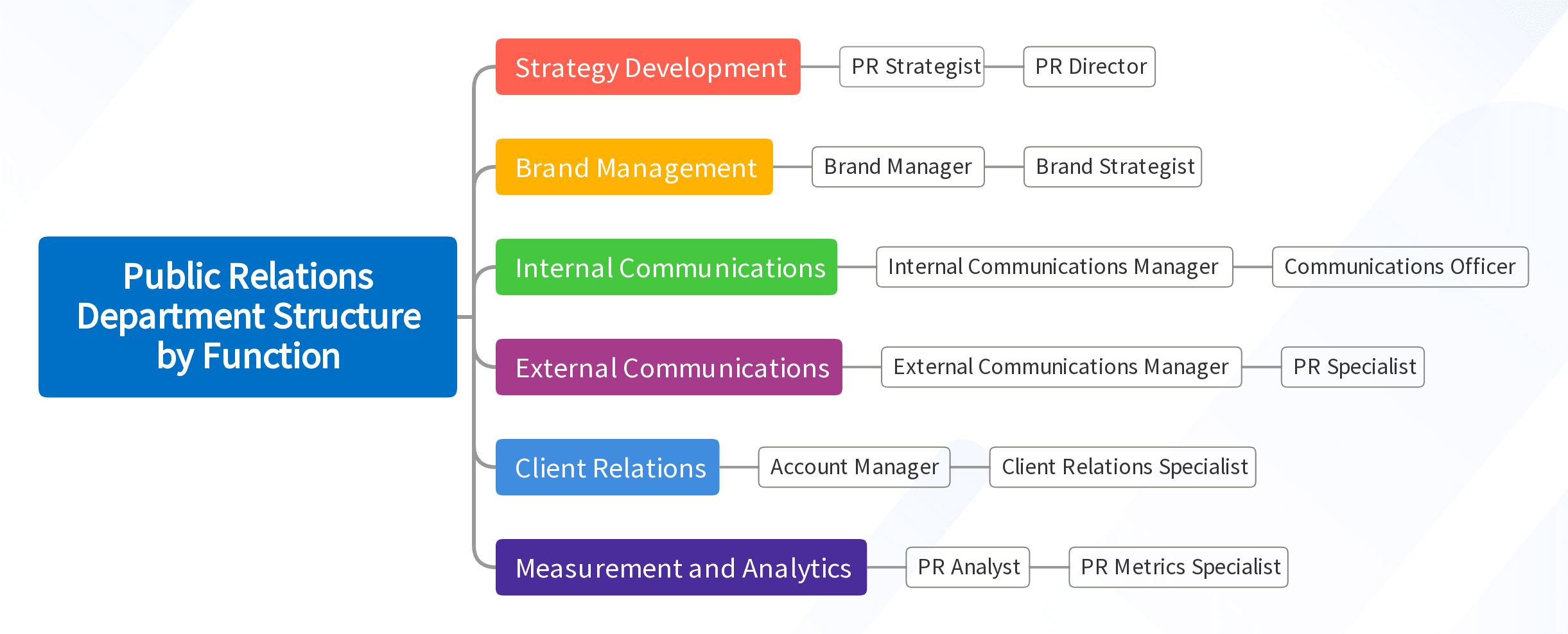

Public Relations teams serve as vital links in today's fast-paced business world. Their role is to shape public opinion and build strong, lasting relationships.
Structuring such a team requires a careful approach. Considerations include team size, skill sets required, and the specific roles each member will play. I've learned this firsthand while growing my own marketing agency, GrantSpark.
But first, let's talk about the Public Relations department structures you have to choose from.
Best for Growth Marketers
Best for Paid Ads & CMO's
Table of Contents
Structuring Public Relations Department
There are two main types of department structures based on company size and resources.
- Public Relations department structure by discipline
- Org Type: Traditional corporate departments
- Best For: Midsize/Enterprise companies
- Public Relations department structure by function
- Org Type: Employees are grouped by activities and objectives
- Best For: Small to Medium Sized Business (SMB)
Let’s go in-depth to each one of them.
1. Public Relations Department Structure by Discipline


Discipline-based structure involves building teams centered around various marketing disciplines. For example, SEO, Content, Market Research, and Product Strategy could each form separate teams within a department.
| Discipline | Key Skills | Potential Roles |
|---|---|---|
| Media Relations | Storytelling, Media networking, Crisis management | Media Relations Manager, Press Secretary |
| Social Media | Content creation, Community management, Data analysis | Social Media Specialist, Social Media Manager |
| Content Development | Writing, SEO knowledge, Creative thinking | Content Strategist, Copywriter |
| Event Management | Organizational skills, Budgeting, Communication | Event Coordinator, Event Manager |
| Corporate Communications | Strategic planning, Corporate branding, Internal communication | Communications Director, Corporate Communications Specialist |
| Public Affairs | Government relations, Policy knowledge, Advocacy | Public Affairs Specialist, Government Relations Officer |
| Investor Relations | Financial literacy, Strategic communication, Relationship management | Investor Relations Manager, Financial Communications Specialist |
| Community Engagement | Interpersonal skills, Local awareness, Stakeholder management | Community Engagement Officer, Community Relations Manager |
2. Public Relations Department Structure by Function


Another approach is structuring by function, where teams are formed based on the different functions they perform. For example, promotion, launches, and relationship management could all be separate teams.
| Function | Key Skills | Potential Roles |
|---|---|---|
| Strategy Development | Strategic thinking, Problem solving, Analytical skills, Creativity | PR Strategist, PR Director |
| Brand Management | Branding, Market research, Creativity, Strategic communication | Brand Manager, Brand Strategist |
| Internal Communications | Interpersonal skills, Empathy, Writing skills, Strategic communication | Internal Communications Manager, Communications Officer |
| External Communications | Media liaison, Writing skills, Crisis management, Strategic communication | External Communications Manager, PR Specialist |
| Client Relations | Customer service, Relationship management, Problem solving, Communication | Account Manager, Client Relations Specialist |
| Measurement and Analytics | Data analysis, Strategic thinking, Problem solving, Reporting | PR Analyst, PR Metrics Specialist |
Public Relations Team Size versus Business Scale
To achieve successful marketing outcomes, you need to align the team size with your business's scale – a strategic approach that helps optimize resources and drive targeted growth.
| Business Scale | Ideal Department Size | Explanation |
|---|---|---|
| Start-up | 1-2 | Minimal resources, focus on core growth strategies. |
| Small-Medium Business | 3-5 | Increased needs, but maintaining budget control. |
| Large Enterprise | 6+ | Complex needs require larger, specialized teams. |
Factors to Consider When Deciding On a Public Relations Department Structure
- Company Size: Consider the size of your organization. Smaller companies might only need a few PR professionals, while larger corporations may require a whole department.
- Industry Type: The nature of your industry will also impact your PR team structure. More competitive sectors may need a more aggressive PR approach, requiring additional resources.
- Business Objectives: Align your PR team structure with your business goals. If expanding market reach is a priority, you may need team members specialized in different regions or industries.
- Budget Limitations: Financial resources will inevitably impact your PR team structure. Be realistic about what your company can afford without compromising other areas of operation.
- Future Projections: Consider where your company is headed. If growth or diversification is in the future plans, your PR team should be structured to handle these changes effectively.
Explore other marketing departments:
- Performance Marketing Team Structure
- Field Marketing Team Structure
- Content Marketing Team Structure
So, there you have it, a detailed overview of a Public Relations team structure. From the essence of the team and key roles, to structuring and optimizing; every aspect tailored to achieve success on your business blueprint.




















